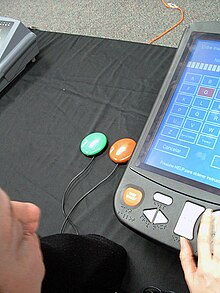DRE voting machine
| Part of a series on |
| Election technology |
|---|
| Technology |
| Terminology |
|
| Testing |
| Manufacturers |
| Related aspects |
A direct-recording electronic (DRE) voting machine records votes by means of a ballot display provided with mechanical or electro-optical components that can be activated by the voter (typically buttons or a touchscreen); that processes data by means of a computer program; and that records voting data and ballot images in memory components. After the election it produces a tabulation of the voting data stored in a removable memory component and as printed copy. The system may also provide a means for transmitting individual ballots or vote totals to a central location for consolidating and reporting results from precincts at the central location.
In 2004, 28.9% of the registered voters in the United States used some type of direct recording electronic voting system, up from 7.7% in 1996.
Benefits of DRE voting machines

Like all voting machines DRE systems increase the speed of vote counting. They can also incorporate the most broad assistive technologies for the largest classes of handicapped people, allowing them to vote without forfeiting the anonymity of their vote. These machines can use headphones and other adaptive technology to provide the necessary accessibility. DRE's can also provide the most robust form of immediate feedback to the voter detecting such possible problems as undervoting and overvoting which may result in a spoiled ballot. This immediate feedback can be helpful in successfully determining voter intent.
Additionally, with DRE voting systems there is no risk of exhausting the supply of paper ballots, and remove the need for printing of paper ballots, a significant cost.[1] When administering elections in which ballots are offered in multiple languages (in some areas of the United States, public elections are required to by the National Voting Rights Act of 1965), DRE voting systems can be programmed to provide ballots in multiple languages on a single machine. For example, King County, Washington's demographics require them under U.S. federal election law to provide ballot access in Chinese. With any type of paper ballot, the county has to decide how many Chinese-language ballots to print, how many to make available at each polling place, etc. Any strategy that can assure that Chinese-language ballots will be available at all polling places is certain, at the very least, to result in a lot of wasted ballots.
Demonstrated Laboratory Attacks
- Diebold Election Systems AccuVote-TS (Manipulation of the votes by the Princeton University.)[2]
- Nedap ES3B (Manipulation of the votes by a citizen group)[3][4]
- SDU voting computers (Violating the secrecy of the ballot using Van Eck phreaking, tested by the Dutch secret service AIVD)[5]
See also
References
- ^ "http://post-journal.com/articles.asp?articleID=6218". The Post-Journal
- ^ Security Analysis of the Diebold AccuVote-TS Voting Machine
- ^ Nedap/Groenendaal ES3B voting computer, a security analysis
- ^ Dutch citizens group cracks Nedap's voting computer
- ^ Use of SDU voting computers banned during Dutch general elections (Heise.de, 31. October 2006)
External links
This July 2008's use of external links may not follow Wikipedia's policies or guidelines. |
- ProCon's "Do electronic voting machines improve the voting process?" review
- Aussies Do It Right: E-Voting by Kim Zetter at Wired
- David Allen's Black Box Voting website
- Bev Harris's Black Box Voting website
- AEI-Brookings Election Reform Project
- Electronic voting website by Rebecca Mercuri
- European Association Electronic Libre
- National Committee for Voting Integrity
- Open Voting Consortium — group which advocates using open source electronic voting systems with paper ballots.
- The Problem with Electronic Voting Machines by Bruce Schneier (security expert)
- Verified Voting
- Election Glitches: The Secret Dangers of Electronic Voting Machines at California Connected Newsroom
- The Machinery of Democracy: Protecting Elections in an Electronic World from the Brennan Center for Justice Voting System Security Task Force
